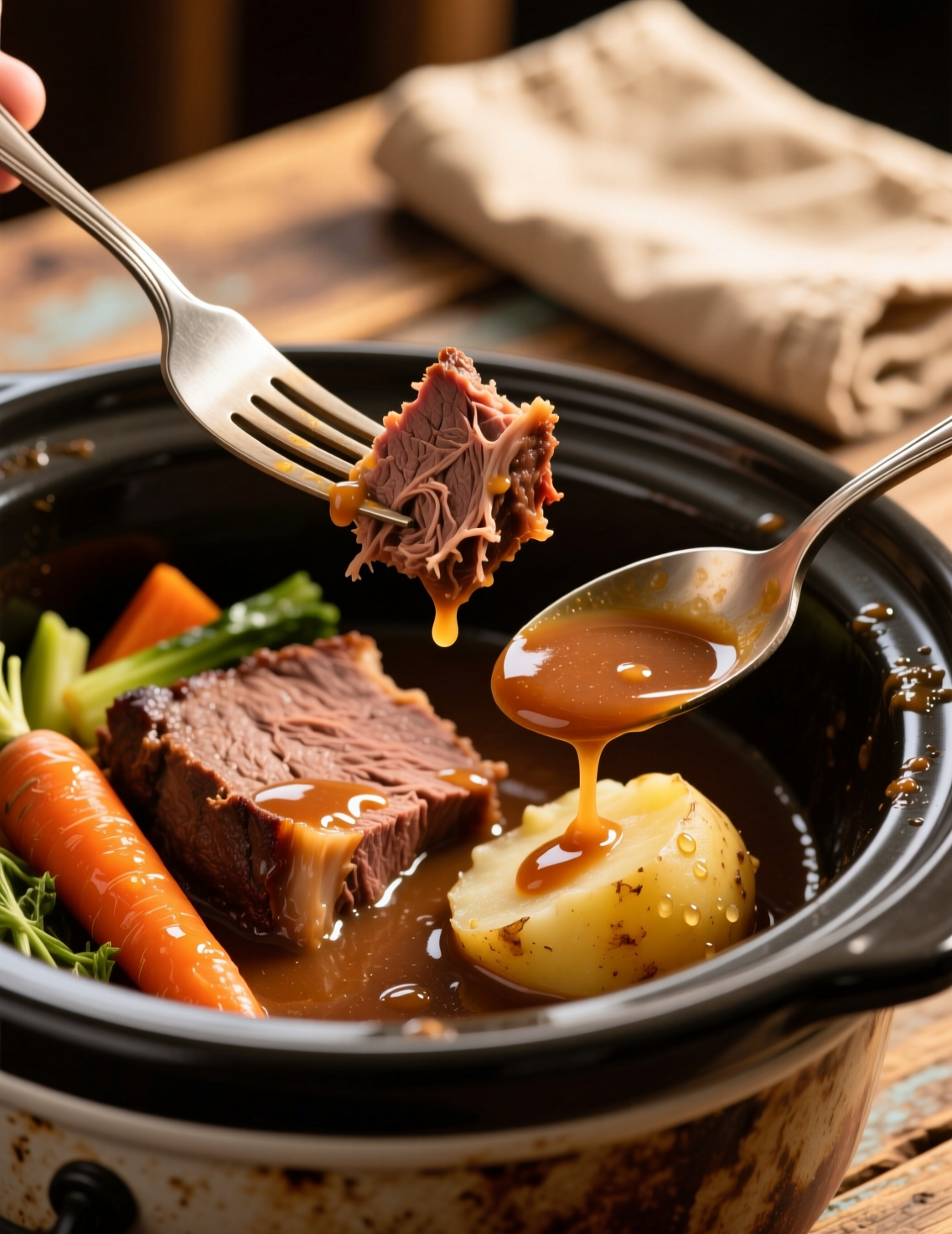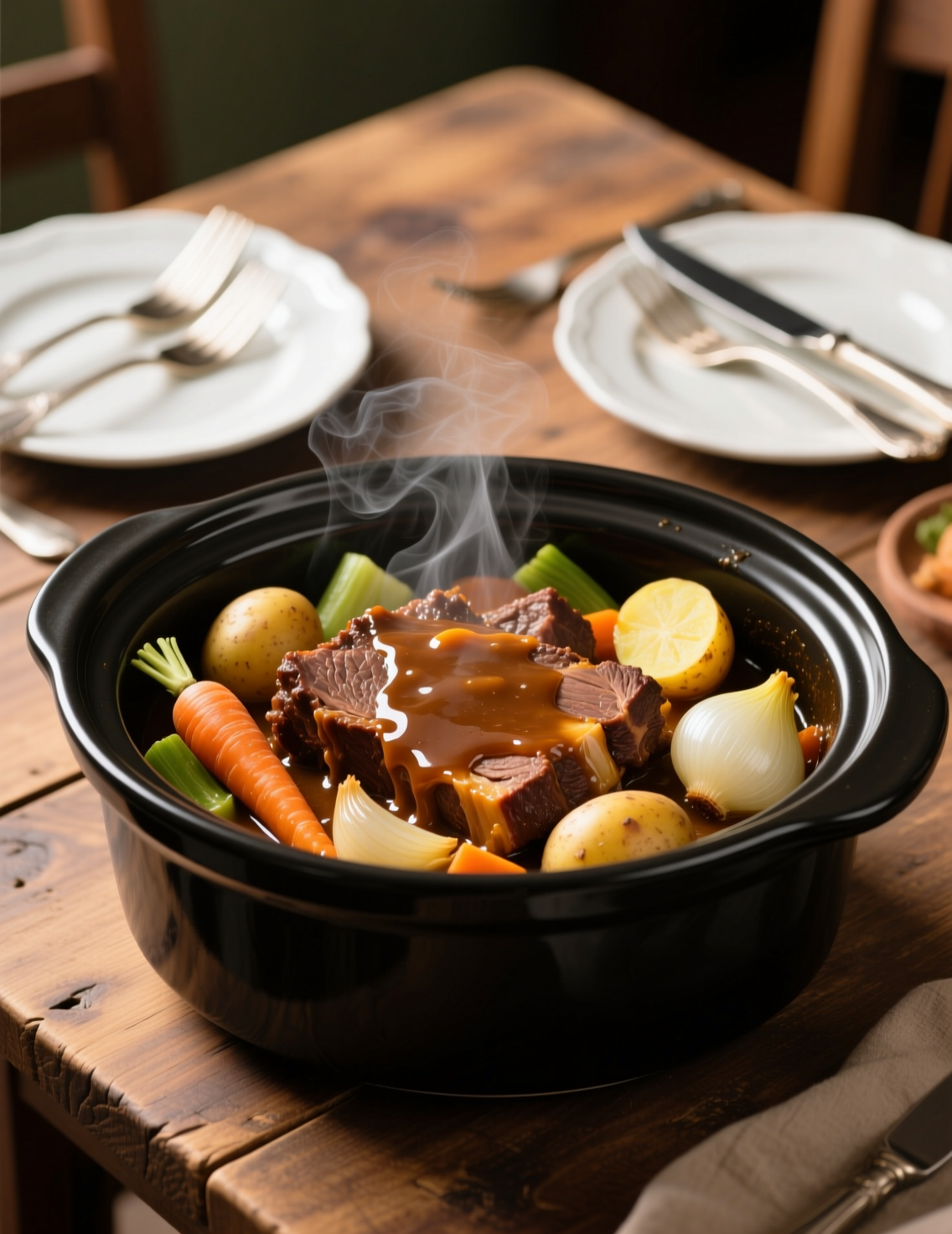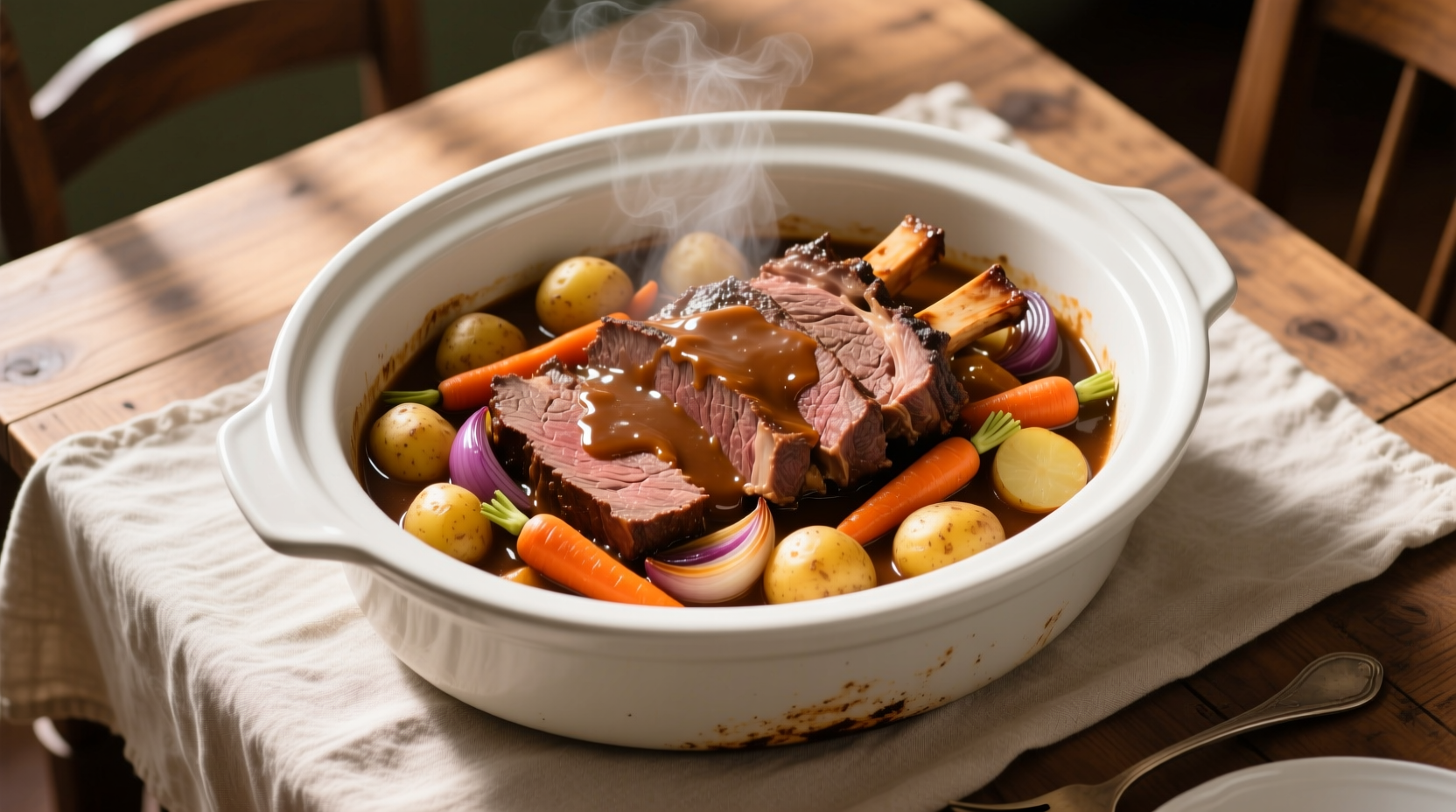There are few dishes that command a table the way a well-cooked chuck roast does. The slow, almost lazy magic of a crockpot transforms a tough cut of beef into something melt-on-your-fork tender, while vegetables soak up every ounce of flavor like sponges you don’t wanna throw away. This isn’t just another Sunday dinner—it’s a masterclass in patience, timing, and knowing when to let the ingredients speak for themselves. Today we’ll dig into how to prepare a crockpot chuck roast with vegetables for six servings, but with the nuance and detail that professionals and serious home cooks appreciate.
Why Chuck Roast is the Star
Chuck roast isn’t tender by default. It comes from the shoulder, a muscle that does heavy work and builds connective tissue. Those fibers make it tough if cooked quickly, but that toughness is exactly what gives it flavor depth. Low and slow heat is its redemption arc.
Crockpots, with their even low-temperature cooking environment, break down collagen into gelatin. Gelatin gives roast that glossy, lip-smacking finish you don’t get from leaner cuts. A braised brisket or shank can pull off similar magic, but chuck roast balances cost, marbling, and flavor in a way few other cuts can.
Professional kitchens lean into this. Chefs use chuck for ragùs, stews, and braises because it doesn’t dry out. In fact, one 2022 survey by the National Cattlemen’s Beef Association found chuck accounted for nearly 30% of all beef cuts used in food service for braised dishes. That tells you something—chefs don’t gamble with consistency.
The Role of Vegetables
Vegetables here aren’t afterthoughts. They’re co-stars, each bringing their own note to the final symphony. Carrots lend sweetness that balances beef’s richness. Potatoes provide earthy bulk, soaking in juices till they’re practically confit. Onions are the silent heroes, breaking down into the broth and enriching everything else.
Celery? Often skipped by home cooks, but pros rarely leave it out. It adds an herbal backbone, a whisper of bitterness to keep the stew from veering too sweet. You’re not just filling bellies with vegetables—you’re layering flavor profiles.
And here’s something interesting: studies from the Journal of Food Science (2020) show that root vegetables cooked at low temperatures in moist environments retain more beta-carotene than high-heat roasting. That means your crockpot roast isn’t just hearty—it’s nutritionally smarter than you’d think.

Core Ingredients for Six Servings
To scale properly, you want balance. Too much beef overwhelms, too many vegetables turn the roast into a soup. For six, this ratio works almost every time:
- 3 to 3.5 pounds chuck roast (trimmed but leave some fat cap intact)
- 4 large carrots, cut in thick batons
- 5 medium potatoes, chunked into 2-inch pieces
- 2 onions, quartered
- 3 celery stalks, rough cut
- 4 garlic cloves, smashed
- 2 cups beef stock (low sodium preferred)
- 1 cup red wine (dry, something you’d actually drink)
- 2 tbsp tomato paste
- 2 sprigs fresh rosemary
- 2 sprigs thyme
- 2 bay leaves
- Kosher salt and black pepper, to taste
- 2 tbsp vegetable oil for searing
This spread doesn’t just hit taste—it covers mouthfeel, aroma, and presentation. You want those big, rustic chunks of veg that hold their own when the beef takes center stage.
Technique: Where Many Go Wrong
Cooking chuck roast in a crockpot sounds foolproof, but corners cut show up in the final plate. The first mistake? Skipping the sear. Browning the roast on high heat before it hits the crockpot builds the Maillard reaction—those savory brown crust notes that separate “good” from “professional.”
Second misstep? Dumping raw tomato paste into liquid. Always bloom it in oil first, let it caramelize a bit. This takes away its raw metallic taste and deepens the base.
And one more—timing your vegetables. Potatoes and carrots can withstand the long cook, but softer veg like mushrooms or peas need to be added in the last hour. Too early, and they collapse into mush. Professional kitchens treat crockpot layers the way pastry chefs treat lamination—precise, timed, deliberate.
Step-by-Step Cooking Process
- Prep the roast: Pat it dry, season generously with salt and pepper. Moisture is the enemy of browning.
- Sear: Heat oil in a heavy skillet until just shy of smoking. Sear roast on all sides until dark golden, about 4 minutes per side.
- Deglaze: Add tomato paste to the pan, stir, then pour in wine. Scrape every fond bit off the bottom—this is concentrated flavor.
- Layer crockpot: Place onions, carrots, celery, and garlic at the base. Nestle the seared roast on top. Surround with potatoes.
- Add liquid: Pour in stock and deglazed wine mixture. Toss in herbs and bay leaves.
- Cook: Cover and cook on low for 8–9 hours, or high for 5–6. Low is better, but high still delivers if time is short.
- Finish: Remove roast carefully—it’ll be fall-apart tender. Discard herb stems and bay leaves. Taste broth, adjust seasoning.
What you’re left with is a roast that needs almost no knife. Vegetables that are tender but structured. A broth that could be sipped from a mug if you’re feeling indulgent.

Professional Tips That Elevate the Dish
- Rest the meat: Even braised, it benefits from 10 minutes outside the pot before slicing or shredding.
- Thicken the sauce: Whisk a slurry of cornstarch and water into the hot broth if you want more body. Professionals often reduce the cooking liquid on the stovetop before serving for a glossy sauce.
- Flavor layers: Add umami boosters like Worcestershire sauce or soy—sparingly. They’re secret weapons.
- Acidity balance: A splash of red wine vinegar before serving brightens everything. Without it, the dish risks heaviness.
Variations Across Kitchens
Every culture spins chuck roast differently. In French kitchens, pot-au-feu leans heavily on leeks and turnips. Italian brasato al Barolo swaps beef stock for rich wine and adds cloves for warmth. In the American South, some chefs sneak in Worcestershire and finish with parsley for freshness.
This recipe framework is universal. Swap potatoes for parsnips, carrots for rutabaga. Or fold in pearl onions near the end for sweetness. Professionals rarely lock themselves in; they riff based on seasonality and pantry.
Nutritional Breakdown for Six Servings
A 3-pound roast with vegetables yields roughly:
- Calories per serving: 520
- Protein: 45g
- Fat: 25g (with trimming, more if fat cap left intact)
- Carbs: 28g
- Fiber: 5g
- Iron: 20% daily value
Balanced enough to serve as a main meal, though most chefs would pair it with bread or salad. Nutritionally, this dish edges on high-calorie, but that’s expected—comfort food with backbone, not a light lunch.
Common Questions
Can I skip the wine? Yes, but you’ll lose depth. Replace with more stock plus 1 tbsp balsamic vinegar for acidity.
Why not cook on high the whole way? Collagen breakdown happens best at lower sustained temps. High risks uneven textures.
Will frozen beef work? Technically, but unsafe. Crockpots don’t heat fast enough to push frozen meat through the danger zone. Always thaw first.
Can I prep this overnight? Absolutely. Assemble everything in the insert, refrigerate, then start cooking next morning. Just don’t put a cold ceramic insert straight into a hot crockpot—thermal shock can crack it.
The Emerging Trends in Slow Cooking
Crockpots, once written off as relics of the ‘70s, are seeing revival. A 2023 Kitchen Appliance Report noted a 15% rise in slow cooker sales after TikTok trends boosted recipes like Mississippi Pot Roast. Professionals see this as a win—it reconnects people with long-form cooking, something fast food culture chipped away at.
Chefs now experiment by using sous-vide precision to pre-cook roasts, then finish in a crockpot for vegetable infusion. Others swap beef entirely for plant-based proteins but still rely on the same vegetable layering and low-temp cooking. The principles hold.
Conclusion
A crockpot chuck roast with vegetables isn’t complicated, but it rewards every ounce of attention to detail. Choosing chuck, searing properly, layering vegetables, balancing acidity—all small decisions that turn ordinary into extraordinary. For six servings, this dish provides not just food but a shared moment.
Professional cooking thrives on repetition and refinement, and this roast embodies that. It’s the kind of dish chefs revisit, tweak, and never quite retire. If you respect the process and let time do the work, the crockpot will give back more than you put in.
So next time you set out a chuck roast for the crockpot, remember—you’re not just cooking beef. You’re orchestrating flavor, chemistry, and patience into one of the most dependable meals a table can hold.
FAQs
Can I make this crockpot chuck roast without wine?
Yes, replace the wine with beef stock and a splash of balsamic vinegar for depth.
How long should I cook a 3-pound chuck roast in the crockpot?
About 8–9 hours on low or 5–6 hours on high.
Do I need to sear the roast before slow cooking?
Yes, searing builds flavor and adds a rich crust that deepens the dish.
Can I use baby potatoes instead of large ones?
Absolutely, just leave them whole or halve them for even cooking.
Should the vegetables go in first or last?
Put root vegetables at the bottom, soft veggies later in the cook.
Can I prep this meal the night before?
Yes, assemble it in the crockpot insert, refrigerate, and start cooking the next day.
Is it safe to cook frozen chuck roast in a crockpot?
No, always thaw first to avoid food safety risks.
How do I thicken the broth into a gravy?
Whisk in a cornstarch slurry or reduce the liquid on the stovetop.
What herbs pair best with chuck roast?
Rosemary, thyme, and bay leaves add depth and balance.
How many people does this recipe serve?
The recipe makes about six hearty servings.

Mariana is a passionate home cook who creates delicious, easy-to-follow recipes for busy people. From energizing breakfasts to satisfying dinners and indulgent desserts, her dishes are designed to fuel both your body and hustle.
When she’s not in the kitchen, she’s exploring new flavors and dreaming up her next recipe to share with the Foodie Hustle community.

